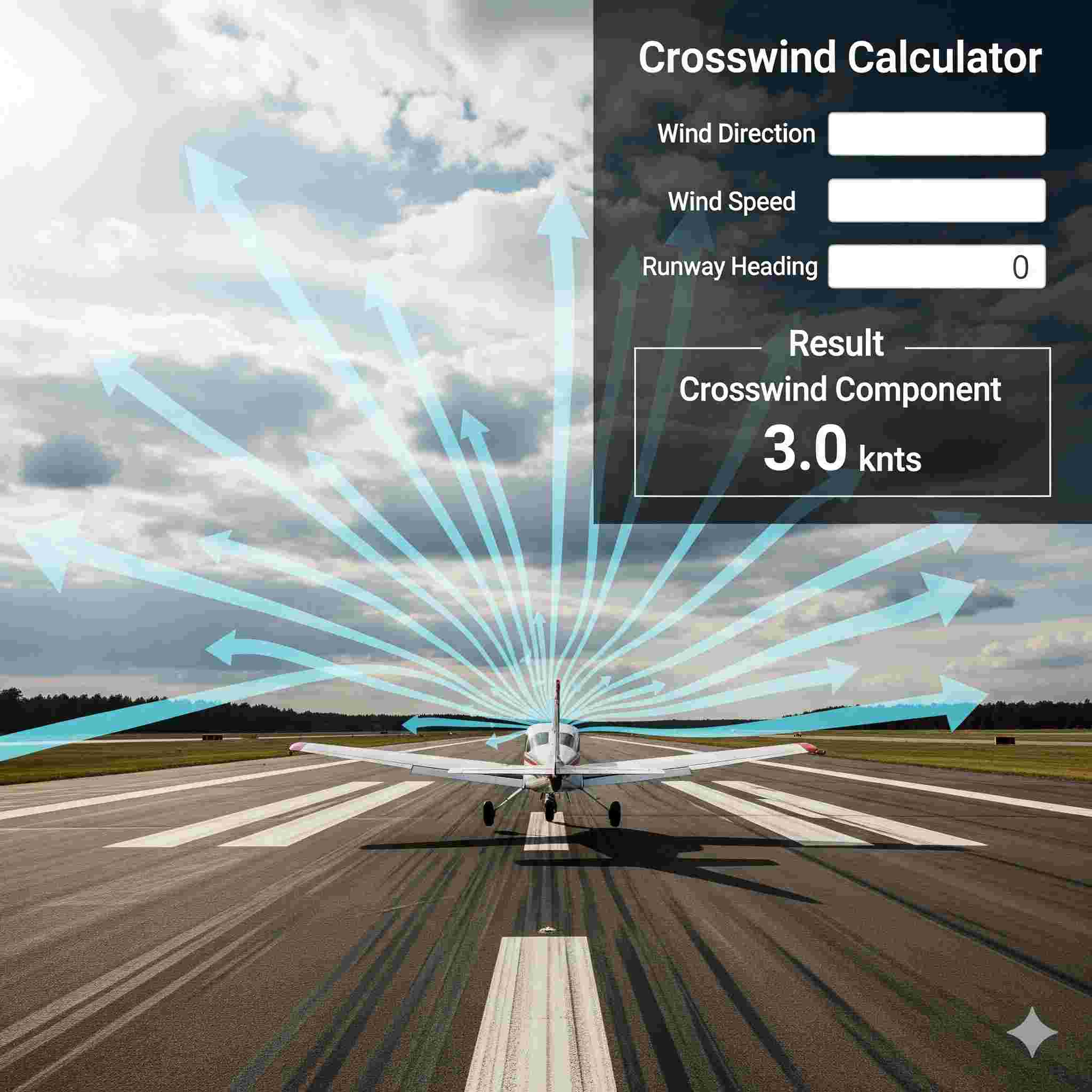Crosswind Calculator
Input
Results
Runway Visualizer
Crosswind Calculator – Accurate Crosswind & Headwind Tool
Free online tool for pilots to calculate crosswind, headwind, and tailwind components easily & accurately.

✈️ What is a Crosswind Calculator?
A Crosswind Calculator is an aviation tool used to compute two important components of wind relative to a runway centerline: the crosswind component (perpendicular to the runway) and the headwind/tailwind component (parallel to the runway). Pilots use these values before takeoff and landing to determine runway selection, assess aircraft handling requirements, and ensure operations remain within aircraft limitations.
Why it matters: runway alignment with prevailing winds reduces ground track corrections, helps achieve shorter landing distances (when headwind), and ensures safe directional control. Incorrect or missing crosswind information can lead to challenging approaches, higher landing speeds, or runway excursions.
This page provides a practical calculator, detailed explanations of the underlying trigonometry, worked examples, guidance on limits, and pilot techniques for handling crosswinds safely.
⚙️ How the Crosswind Calculator Works
The calculator needs three inputs:
- Runway heading (in degrees) — this is the magnetic or true runway heading you choose to use. Use the same reference (magnetic or true) for both runway and wind.
- Wind direction (in degrees) — the direction the wind is blowing from (meteorological convention).
- Wind speed — usually in knots, but you can convert from mph or km/h.
The calculator computes the angular difference between the runway heading and the wind direction, then applies trigonometry (sine and cosine) to split wind speed into perpendicular (crosswind) and parallel (headwind/tailwind) components.
Important implementation note: we normalize angles to the range 0–360°, then take the minimal angle between the two headings (0–180°) so the sine/cosine give correct magnitudes. Crosswind direction (left or right) can be deduced by the sign of the angular difference if needed.
🧮 Crosswind Formula Explained
Using standard trigonometry, given a wind speed V and an angle difference θ between the wind direction and runway heading (in degrees):
Crosswind = V × sin(θ) Headwind = V × cos(θ)
Notes:
- θ should be the smallest angle between runway heading and wind direction (0 ≤ θ ≤ 180).
- If cos(θ) is positive the component is headwind; if negative it is tailwind (we often display absolute value and label as headwind/tailwind).
- Sine and cosine expect angles in radians when calculated programmatically — convert degrees to radians first: radians = degrees × π / 180.
Example: V = 20 knots, runway = 090°, wind = 120° → θ = 30°. Crosswind = 20 × sin(30°) = 10 kn. Headwind = 20 × cos(30°) ≈ 17.32 kn.
🔢 Interactive Crosswind Calculator
Enter values below and press Calculate. Use the same reference (magnetic or true) for runway and wind.
- Use measured winds (METAR/ATIS) when possible.
- Compare computed crosswind to your aircraft’s demonstrated/limiting component.
- If gusting, use peak gust value for conservative planning.
📌 Worked Examples of Crosswind Calculations
Example 1 — Small crosswind
Runway heading = 090°, Wind direction = 120°, Wind speed = 15 knots.
Angle difference = 120 – 90 = 30°. Crosswind = 15 × sin(30°) = 7.50 kn. Headwind = 15 × cos(30°) ≈ 12.99 kn.
Example 2 — Stronger crosswind
Runway heading = 270°, Wind direction = 300°, Wind speed = 20 knots.
Angle difference = 300 – 270 = 30°. Crosswind = 20 × sin(30°) = 10 kn. Headwind = 20 × cos(30°) ≈ 17.32 kn.
Example 3 — Tailwind component present
Runway heading = 360°, Wind direction = 200°, Wind speed = 18 knots.
Angle difference normalized: (200 – 360) = -160° (or 200°). Minimum angle absolute = 160°. Crosswind = 18 × sin(160°) ≈ 18 × 0.342 ≈ 6.16 kn. Headwind = 18 × cos(160°) ≈ -16.92 kn (negative indicates a tailwind of ~16.92 kn).
These examples illustrate the importance of using sign conventions and labeling headwind vs tailwind clearly when presenting results.
🛩️ Aircraft Crosswind Limits & Guidance
Every aircraft has published limitations or demonstrated crosswind components. The demonstrated crosswind is often found in the Pilot Operating Handbook (POH) or aircraft flight manual and represents the highest crosswind used during certification testing — not a strict operational limit in every case, but a valuable guideline.
Rule of thumb: If computed crosswind approaches or exceeds the demonstrated crosswind for your aircraft, consider selecting another runway or diverting. For student pilots and early training flights, instructors often apply a lower operational limit than the aircraft’s demonstrated value to maintain safety margins.
| Aircraft type (example) | Typical demonstrated crosswind | Operational advice |
|---|---|---|
| Light single (Cessna 172) | ~15–20 kn | Students: use a lower limit (10–12 kn). Experienced: follow POH guidance and conditions. |
| Complex piston twins | ~20–25 kn | Consider gusts and controllability—favor lower approach speeds if safe. |
| Regional jets & airliners | ~30 kn (varies) | Follow airline SOPs & landing performance charts. |
Always factor in gust spread — the difference between steady wind and peak gust. For planning, many pilots add half the gust spread to the steady wind when assessing limits (conservative approach).
🌤️ Reading METAR / ATIS for Wind Component
METAR example: METAR VABB 291630Z 24012G22KT 9999 FEW020
In this METAR the wind is 240° at 12 knots gusting 22. Use the gust value (22) if planning conservatively. Convert runway numbers to degrees (runway 09 = 090°) and plug into the calculator.
Tips:
- Use the gust speed for conservative crosswind planning.
- Watch for rapidly changing winds — frequent METARs or TAFs will show trends.
- Note wind shear or low-level wind changes during approach; these are not captured by a single METAR reading.
🛬 Pilot Techniques for Crosswind Landings
Two widely used techniques for crosswind landings are crab and wing-low (slip) approaches.
Crab technique
Maintain a heading into the wind to cancel cross-track drift. Just before touchdown, apply rudder to align the aircraft with the runway while simultaneously applying aileron to prevent drift (called a “de-crab”). This reduces side-loading on the landing gear when correctly timed.
Wing-low (sideslip) technique
Use a combination of opposite aileron (into the wind) and rudder (to align nose with runway). This keeps the aircraft aligned throughout touchdown and maintains better directional control at touchdown, but requires precise control inputs.
Short-field considerations and strong gusts
In gusty conditions, increase approach speed per POH recommendations (commonly half the gust spread) to maintain control authority. For short-field operations, ensure touchdown occurs within the desired zone—crosswinds complicate this and conservative decisions may call for a go-around or different runway selection.
💡 Operational Tips & Best Practices
- Always verify whether runway headings and wind directions are both magnetic or both true — mixing references will produce incorrect results.
- If uncertain, use the magnetic runway numbers (e.g., Runway 09 = 090° magnetic) as shown on airport charts and ATC clearances.
- When gusting, use the peak gust value for crosswind calculation and add a safety margin.
- Confirm landing gear and flaps procedures in crosswinds with your POH — some aircraft have recommended techniques for high crosswind landings.
- Practice crosswind techniques regularly with an instructor to build confidence and competence.
Decision-making checklist before landing:
- Compute crosswind and headwind/tailwind components.
- Compare crosswind to aircraft demonstrated/operational limit.
- Check runway length and surface conditions (wet/contaminated runways reduce braking effectiveness).
- Assess gusts and wind shear potential.
- Plan a go-around point and brief a crosswind landing technique with your crew/instructor.
❓ Frequently Asked Questions (FAQs)
What is a crosswind component?
The crosswind component is the part of the wind blowing perpendicular to the runway centerline. It affects directional control and side-loading on the landing gear and may influence runway selection.
Should I use true or magnetic headings?
Use the same reference for both runway and wind. In most practical applications on the ground and in ATC communications, magnetic headings are used (runway numbers are magnetic rounded headings).
Is the demonstrated crosswind a strict limit?
Not always. Demonstrated crosswind is the maximum used in certification testing. Airline/operator SOPs, instructor guidance, and POH notes determine the operational limit and can be stricter than the demonstrated value. For student pilots, lower operational limits are common.
How do gusts affect crosswind planning?
Gusts increase peak wind speeds and can change control requirements at touchdown. For conservative planning, many pilots use the gust speed (or add half the gust spread to steady wind) when evaluating crosswind suitability.
Can crosswind be negative?
Crosswind magnitude is always positive; however, the signed angle difference indicates whether wind is from left or right. Headwind component can be negative (indicating tailwind).
How do I convert between knots, mph and km/h?
1 knot = 1.15078 mph ≈ 1.852 km/h. Convert before or after computation depending on your preferred units.
📚 Glossary
- Crosswind
- Component of wind speed perpendicular to runway centerline.
- Headwind
- Component of wind speed parallel to runway pushing the aircraft toward the runway on landing (positive headwind reduces groundspeed).
- Tailwind
- Parallel component pushing the aircraft down the runway (increases groundspeed and landing distance).
- METAR
- Routine aviation weather report giving wind, visibility, cloud ceilings, and more.
📖 References & Further Reading
For authoritative guidance consult:
This tool is intended as an aid and educational resource. Always cross-check with your aircraft manual, SOPs and current official weather sources before flight.
🚀 Try Our Other Tools
Explore more calculators: SIP Calculator, .
